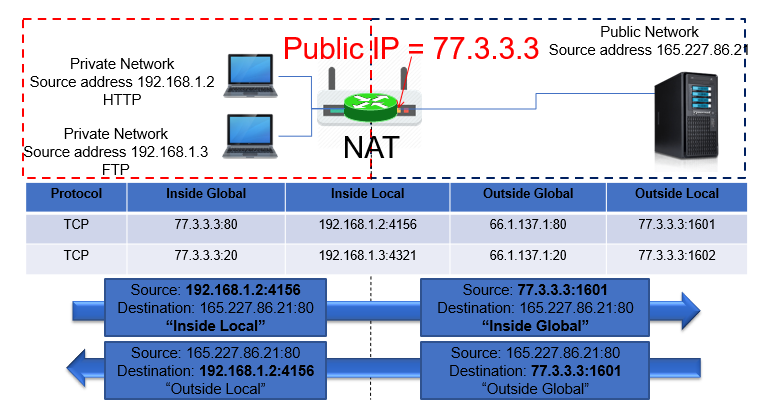Network Address Translation (NAT) and Network Port Address Translation (NPAT) are not considered a security function because its primary purpose is to modify the L3 network address information in IPv4 packet headers and L4 port numbers of TCP or UDP while in transit. NAT and NPAT are not needed in IPv6 networking.
NAT is primarily designed to conserve public IP addresses and allow multiple devices on a local network to share a single public IP address. It translates private IP addresses to a public IP address (or vice versa) and keeps track of these mappings.
NPAT (also known simply as Port Address Translation, PAT) extends NAT by translating both IP addresses and port numbers, allowing even more devices to share a single public IP address. An example is shown in the illustration.

Neither NAT nor NPAT inherently include mechanisms for detecting or blocking malicious traffic. While they hides internal IP addresses and perhaps port numbers from the outside world, they do not provide comprehensive security controls like firewalls or intrusion detection/prevention systems.
- No Packet Inspection: NAT and NPAT do not inspect the content of the packets they translate. They only modify the IP address and/or port number in the packet headers.
- No Threat Detection: They do not have mechanisms to detect or block malicious traffic. Unlike firewalls, they cannot analyze traffic patterns or payloads to identify threats.
- No Access Control: NAT and NPAT do not enforce access control policies. They do not filter traffic based on rules or policies that define what traffic is allowed or denied.
NAT modifies IP addresses and NPAT modifies both the IP Address and Port numbers but neither inspect the contents of the packets for malicious payloads. They forward packets based on the translation rules, not on the basis of content inspection or threat assessment.
For a network to be secure, additional measures such as firewalls, encryption, and intrusion detection systems are necessary. These systems provide the capability to analyze traffic, detect threats, and enforce security policies.
Relying on NAT or NPAT for security is an example of “security through obscurity,” which is not a robust security practice. While NAT and NPAT can make it harder for an external attacker to identify internal network structures, it does not actively protect against attacks.
- Limited Protection: While NAT and NPAT obscure internal network addresses, making it more difficult for attackers to target specific devices, this is not a reliable security measure. It does not prevent attacks or unauthorized access.
- Not a Substitute for Security: Relying on NAT/NPAT for security is inadequate. Effective security requires additional measures like firewalls, intrusion detection/prevention systems (IDS/IPS), and encryption.
A great example of this issue is discussed in my IPv6 classes. In IPv4 most networks are private IP’s behind the NPAT being translated to a single public IP. So if I am a bad actor and I want to scan your network, I need to know your public IPv4 address. Then I scan all 65535 ports using multiple L4 protocols and I can discover your devices behind the NAT. That is almost too easy if you have the right tool. By contrast, in IPv6 we do not have NAT or NPAT. We have 18 Quintillion possible Interface ID’s (IID) for devices to use behind the global unicast prefix. Scanning 18 Quintillion vs 65535 does not sound like fun. Further, with many IPv6 systems, they choose multiple (random) IID’s so they are playing a game of hide and seek where they move addresses around in the pool of 18 quintillion. That means a hacker could have scanned the first 500 million addresses and then my system uses an address that has already been scanned for it’s next connection. I am not saying IPv6 is any more or less secure, but it does take a more active approach to obscuring devices on the network (that is if they support the proper standards for generating temporary IPv6 addresses).
So, while some would argue NAT and NPAT can contribute to security by obscuring internal network addresses, they lack the active security mechanisms required to protect a network from threats and attacks. Effective network security requires dedicated security technologies and practices that go beyond address translation.
- Firewalls and IDS/IPS: These are dedicated security devices or software that inspect, filter, and analyze network traffic to detect and prevent attacks. They provide the necessary security features that NAT/NPAT lack.
- Encryption: Protects data confidentiality and integrity during transmission, which NAT/NPAT do not address.
- Firewalls: Implement rules to allow or deny traffic based on IP addresses, port numbers, protocols, and more.
- IDS/IPS: Monitor network traffic for suspicious activity and can take actions to block or alert on detected threats.
- VPNs: Encrypt traffic to protect data confidentiality and integrity.
NAT and NPAT are not considered security functions. Robust network security requires dedicated security technologies that provide comprehensive protection against a wide range of threats.
Comments are welcomed below from registered users. If you would like to see more content and articles like this, please support us by clicking the patron link where you will receive free bonus access to courses and more, or simply buying us a cup of coffee!

